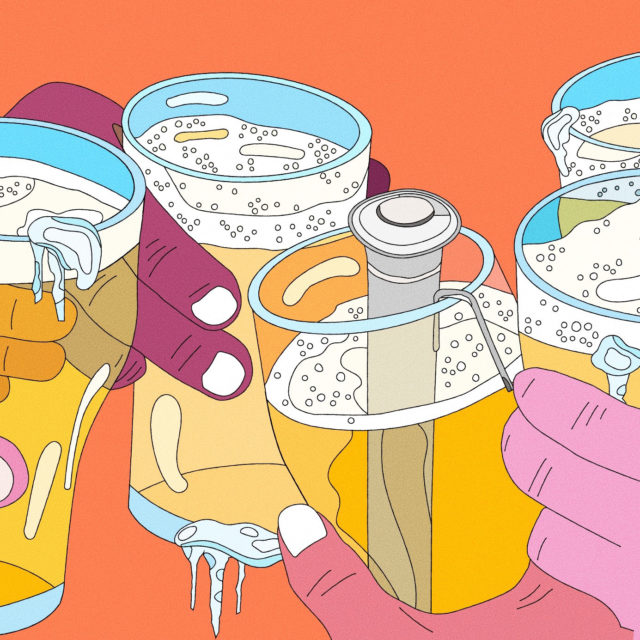In the heat of summer, an ice-cold beer can be an absolute lifesaver. But sometimes a cold beer is simply too cold — especially in the dead of winter, and even more so Central Europe. In this lager-loving and often icy region, cognoscenti have long relied upon a discreet device to bring their beers to the optimal temperature: a beer warmer.
Called a bierwärmer in German, or the slightly harder-to-pronounce ohříváček in Czech, a beer warmer is “a narrow metal tube with a hanger,” Aleš Dočkal, manager of the Prague beer bar Pivovarský Klub, says. “It has a lid, and this little thin container is filled with hot water, closed with the lid, and then hung in the glass. The hanger goes on the glass rim, ohříváček is dipped in the beer, and the consumer makes the beer warmer to [their] taste.”
If that sounds like something from another era, you’re not wrong: Dočkal notes that most of the customers who have asked for a beer warmer at his pub were generally older, and that the beer warmer’s use there has fallen off considerably in recent years.
However, curiosity around this obscure and seemingly counterintuitive device has recently resurfaced, with conversations on Reddit forums, Twitter, and elsewhere sparking interest among beer and history geeks.
Bierwärmer: History and Uses
A few short generations ago, just about every Czech pub would have a fleet of beer warmers arranged on a rack behind the bar, much like the racks of personal mugs that belong to the pub’s regulars.
“It was a popular Christmas present for fathers and grandfathers,” Dočkal says. “They took the ohříváček to the pub and it was left hanging on the wall. They not only got a beer in their favorite glass or mug, but they got it with their favorite beer warmer in it.”
Today, beer warmers are a rare sight even in the homeland of lager brewing — and almost completely unknown outside of it. (In fact, some craft lager brewers contacted for this story replied that they were unaware of the tool.)
Despite its relative obscurity, you can still order a beer warmer on Amazon, or chime in about its use on Reddit (one user recently received a “beer caramelizer” for Christmas).
In Rauchbier’s hometown of Bamberg, beer writer Markus Raupach says that the traditional beer warmer is rarely seen. It is more common, he says, for pubs to warm beers up with a Tauchsiedler, an electric device normally used for warming or boiling water.
“It is more or less a spool or coil made out of steel that heats up when plugged in a socket,” Raupach explains. In many pubs, a Tauchsiedler is kept at the ready, resting in a beer mug filled with water, unplugged. “If a customer wants a pre-warmed beer, they plug it in and put it into a fresh tapped Seidla beer mug for a certain time,” he says. “The [server] normally knows the right time for each customer.”
Changing (Beer) Temperatures
Even in tradition-minded Central Europe, people today drink beer much colder than they did a century or so ago.
“I have a textbook for future waiters and bartenders from the beginning of the 20th century. It has a chapter dedicated to the right beer temperatures, which is very interesting because the recommended temperatures for pale beers are 9 to 11 degrees Celsius [about 48 to 52 degrees Fahrenheit], and for dark beer, 11 to 13 degrees Celsius [about 52 to 55 degrees Fahrenheit],” Dočkal says. “And that was for the summertime. The textbook said these temperatures can go up by another 2 degrees in the winter.”
To put that into perspective, that would mean serving pilsner-style beers at least 10 degrees warmer than the North American preference of almost-ice-cold 38 degrees Fahrenheit; and up to 10 degrees warmer than Dočkal’s preferred serving temperature of 45 degrees Fahrenheit in winter.
Another reason for the beer warmer’s rarity is that pub-goers have more options for warmer beer today. “If they don’t like ‘too- cold’ beer, they can ask for a bottle from the crate in the cellar, instead of one from the refrigerator,” Dočkal says. “Or they ask for a glass that was rinsed in hot water. If that doesn’t work, you can just get a regular beer and let it stand.”
While beer warmers might be slowly dying out, you’ll still see Central Europeans asking for their beers to be warmed up on certain occasions. Dočkal says that people who have a cold or who have other health problems might not want to drink a beer that is super chilled. And for the aforementioned older folks, it’s a harkening back to the region’s more traditional serving temperatures.
Raupach recalls a special case involving some older customers in Germany. “I once met an elderly couple with a dog, I think it was at Mahr’s Bräu,” he says, referring to a traditional, family-run brewery in Bamber. “They ordered three beers, one of them warmed up with the Tauchsieder. When the beers arrived at the table, they put the warm beer into a bowl. It was for the dog.”
Should you find yourself hankering for a warm beer in Bavaria, keep your eyes peeled — and your barstool neighbor’s dog heeled.
This story is a part of VP Pro, our free platform and newsletter for drinks industry professionals, covering wine, beer, liquor, and beyond. Sign up for VP Pro now!
